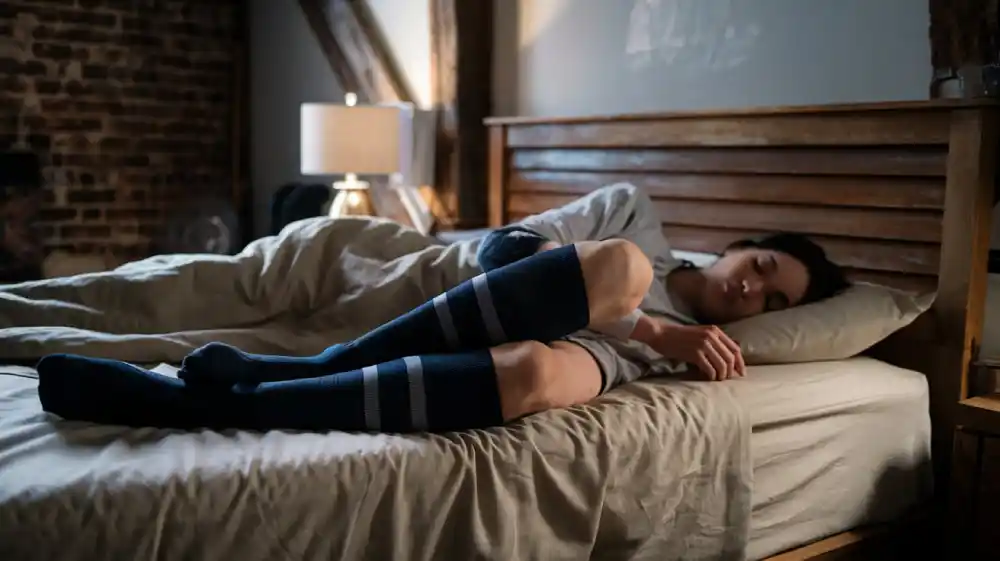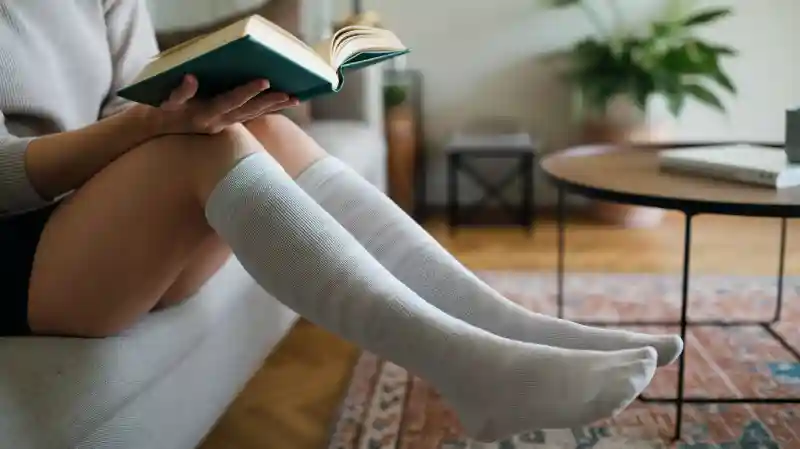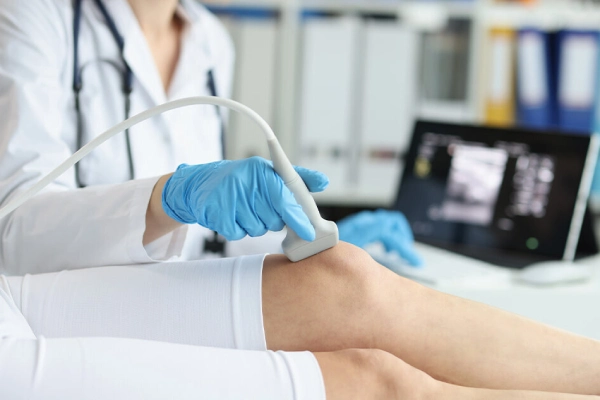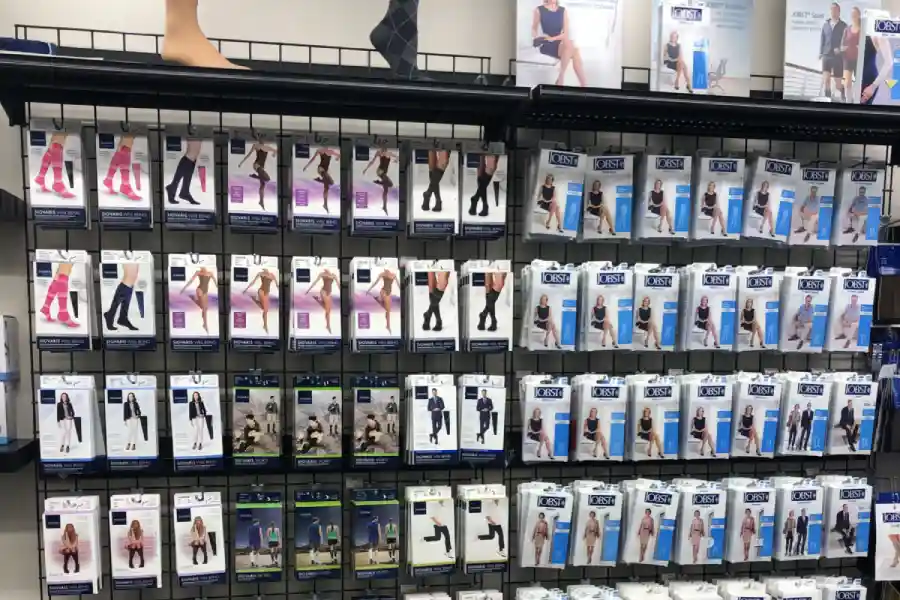“Can I sleep with compression socks on?”
It’s one of the most common questions people ask once they discover how good compression feels during the day.
The honest answer is: some people can safely benefit from nighttime compression — but many people don’t need it, and a few should avoid it completely.
In this guide, we’ll walk through:
- Who actually benefits from sleeping in compression socks
- Who should not wear them overnight
- Red-flag symptoms that mean you should take them off
- How to use compression safely if your doctor recommends nighttime wear
Important: This article is for general education only and is not medical advice.
Always follow the guidance of your own healthcare professional.
The Quick Answer: Is It Safe?

Generally, yes—but with strict conditions.
However, standard high-compression garments (20–30 mmHg and above) designed for standing or running are typically not recommended for sleeping. When the body is horizontal, the gravitational fight against blood flow is reduced. Excessive pressure during sleep can restrict circulation rather than aid it, potentially acting like a tourniquet. For a more consumer-focused overview of nighttime use, see our guide on Sleeping with Compression Socks: Benefits, Risks, and Best Practices.
The Science: Understanding Pressure Levels (mmHg) for Sleep
As a specialized hosiery manufacturer, we understand that “compression” is not one-size-fits-all. The success of a sleep-recovery sock lies in the gradient and the pressure level.
| Compression Level | Best Use Case | Safe for Sleep? |
|---|---|---|
| 8–15 mmHg | Mild support, relief from tired legs. | Yes (Ideal) |
| 15–20 mmHg | Travel, mild swelling, pregnancy. | Yes (With caution) |
| 20–30 mmHg | Medical grade, varicose veins, heavy sports. | No (Unless prescribed) |
| 30+ mmHg | Serious venous conditions. | No (Strictly medical) |
Manufacturing Insight: For brands looking to develop a “Sleep & Recovery” line, we recommend focusing on the 15–20 mmHg range with a graduated profile that is softer at the cuff to prevent constriction.
Market Trends: Who is Buying “Sleep” Compression Socks?

Understanding the end-user helps us design better products. Many vascular specialists highlight compression socks for travelers, athletes and people with venous disease. Three main consumer groups are driving the demand for overnight compression wear:
The Athletic Recovery Market
Athletes are increasingly turning to compression for “passive recovery.” Wearing socks post-workout (and during sleep) can help flush out lactic acid and reduce Delayed Onset Muscle Soreness (DOMS). Product Need: Moisture-wicking materials and targeted arch support.
The Wellness & Pregnancy Sector
Pregnant women and individuals with mild edema often suffer from fluid retention that worsens overnight. Light compression helps manage this fluid balance. Product Need: Ultra-soft, high-stretch fabrics that are easy to put on.
The Travelers and Busy Professionals
After a long day of standing or a long-haul flight, legs can feel heavy (venous insufficiency). Overnight wear acts as a “reset” button for the legs. Product Need: Fashion-forward designs that don’t look like medical equipment.
Designing for Sleep: Key Manufacturing Considerations

Creating a sock that is safe to wear for 8 hours while unconscious requires specific technical details. At Jiaxing Max Hosiery, we prioritize the following specifications for overnight products:
Breathability and Thermoregulation
The body temperature fluctuates during sleep. Heavy nylon blends can cause overheating.
Our Solution: We utilize breathable blends, incorporating materials like Bamboo Fiber, Merino Wool, or Premium Cotton mixed with Spandex. This ensures moisture management and temperature control.
Seam Construction
A bulky toe seam can cause irritation or pressure points when the foot is stationary for hours.
Our Solution: We use Hand-Linked Toes or Seamless Knitting technology to ensure a frictionless experience, critical for sleeping comfort.
The “Non-Binding” Top Band
The biggest risk in overnight wear is the top band cutting off circulation below the knee. The biggest risk in overnight wear is the top band cutting off circulation below the knee.
For more on proper fit and measurements, see our Complete Guide to Compression Sock Sizing.
Our Solution: We engineer wide, non-binding cuffs that hold the sock in place without digging into the skin, ensuring safety for prolonged horizontal wear.
Risks and Contraindications

Transparency builds trust. Brands need to educate their customers. Transparency builds trust. Brands need to educate their customers.
You can also point them to our overview What Are Compression Socks for basic concepts and material choices. Sleeping in compression socks is not suitable for individuals with:
- Peripheral Artery Disease (PAD): Compression can worsen arterial flow.
- Advanced Neuropathy: Loss of sensation may prevent the user from feeling if a sock is too tight.
- Open Skin Wounds: Unless covered by an appropriate dressing.
Disclaimer: Consumers should always consult a healthcare professional before wearing compression garments to bed if they have pre-existing medical conditions.
FAQs About Sleeping with Compression Socks
Is it safe to sleep with compression socks on?
Sleeping in compression socks is usually safe for many people, but it isn’t automatically necessary. Most experts recommend wearing them during the day and taking them off at night, unless a doctor specifically prescribes overnight use for venous disease, ulcers, or post-procedure recovery. If you feel pain, numbness, or skin changes, remove them and seek advice.
Who should not sleep in compression socks?
You should avoid sleeping in compression socks if you have peripheral arterial disease, very poor arterial circulation, advanced neuropathy, uncontrolled heart failure, or open skin wounds on the legs. In these situations, added pressure can further reduce blood flow or irritate fragile skin. Always ask a vascular or primary-care specialist before using compression overnight.
What compression level is best for sleeping?
If your doctor allows nighttime use, low to moderate compression is usually preferred. Levels around 8–15 mmHg or 15–20 mmHg typically provide gentle support without excessive pressure. Stronger medical grades, such as 20–30 mmHg and above, are generally reserved for daytime wear or specific conditions and should only be used in bed under medical supervision.
Can sleeping in compression socks help varicose veins or swelling?
Compression socks are very effective for varicose veins and leg swelling, but most benefit comes from wearing them while you’re upright and gravity is working against your veins. Some patients with venous ulcers or after vein procedures may be told to keep them on longer, sometimes at night. For others, daytime wear alone is usually enough.
Is it okay to sleep in compression socks during pregnancy?
During pregnancy, compression socks can ease swollen, heavy legs and may help prevent varicose veins. Most guidance favors daytime use, with nighttime wear considered only when swelling is significant and a maternity provider agrees it’s appropriate. Pregnant people should use mild to moderate compression, watch for skin irritation, and stop wearing the socks if they feel painful or restrictive.
Conclusion: Elevating Your Product Line

The rising demand for “sleep & recovery” hosiery offers a unique opportunity for brands, but success relies on balancing medical safety with supreme comfort. It requires precise engineering, not just rebranding activewear.
At Jiaxing Max Hosiery, we help brands navigate these technical nuances to create safe, high-quality overnight compression solutions. If you are exploring this niche for your next collection, we invite you to connect with us to discuss breathable materials and optimal pressure profiles.
